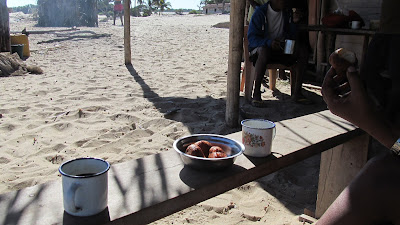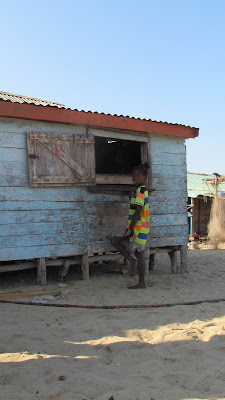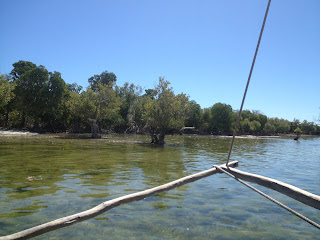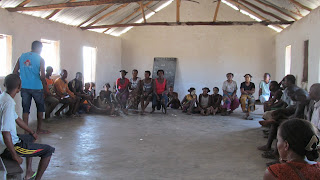"It's a dangerous business, Frodo, going out your door. You step onto the road, and if you don't keep your feet, there's no knowing where you might be swept off to.” J.R.R. Tolkien, The Lord of the Rings
Over the past five years I’ve been up to my hips in peatland and mangrove mud; have tripped, stumbled, slipped and fallen flat on my face (literally and figuratively) in some of the most beautiful forests in the world and some back alleys in some pretty grimy cities. My ego has shrunk (I think) and my heart has expanded (I know ‘cause it’s stuffed with so many more friends).
 |
| Nasri, my excellent colleague - I think I often prompted this look on his face |
 |
| Village in the middle of a lake, Sengkang, South Sulawesi |
But, there was lots of support – other volunteers (especially Margaret and Noelle) were a phone call or text away - and internet connections make it very easy to live in unfamiliar places; you can slip back into your culture and family just by clicking.
 |
| Pak Mahmud's family, Jeneponto, South Sulawesi |
It got better - of course it did. I learned enough language to buy food and get directions, small essentials like that. Often I left the market without getting quite what I wanted. My coworkers were endless sources of help, and in that first volunteer contract I have no doubt that my value to them (regarding the work I was supposed to be supporting) was a fraction of their value to me, from helping with shopping to taking me along to family celebrations.
 |
| Ulysses, Sabangau forest |
And I’ve fallen in love with the natural landscapes and have mind’s-eye pictures of beautiful places where the work has taken me…
In Maros province, South Sulawesi: the first trip up to Bengo-Bengo on winding roads through the Bantimurang Bulusurang National Park, an area of tall, straight up limestone hills, carpeted by huge trees and vines; the second largest karst ecosystem in the world. I took the trip almost weekly between the forest and Makassar on my motorbike, the best part of my job.
From Kalimantan, Indonesian Borneo: Sitting on the narrow front porch of the field house in Sabangau Forest, with a morning cup of coffee watching Ulysses casually walk across the tops of trees less than 50 meters away. Great coffee, amazing view.
 |
| Comet moth, Ranomafana |
In South Sumatra, back in Indonesia: now the work starts to get serious - I had built up an appreciable amount of experience in tropical forests. While working this contract I saw a fair number of air-conditioned conference rooms in upscale hotels - surprisingly (ha!) all very similar.
I’m seaside now, west coast of Madagascar, based in Toliara: If someone had given me the choice of the five contracts so far, I probably would have chosen to work in my current job over all the rest just because it’s centered around mangrove ecosystems which I’ve been interested in since a trip to Belize 10 years ago. But i’m really, really glad I didn’t get that option - seeing the diversity of the peat forest and karst forest in Indonesia and tall eastern rainforest in Madagascar just makes me want to go look at other parts of the world - see what else is out there. Although the mangroves are very cool, of course, and where there aren’t mangroves there are endless stretches of beach.
 |
| Colleagues from Universitas Hasanuddin, Makassar |
Five years isn’t all that long – I’m amazed at the number of people you can meet and the different places you can see in just that relatively short span of time. Now I’ve got so many moments that I can carry with me; singing really bad karaoke with Raymond in Mada, and Nova in Indo; playing incompetent games of pool with Joyo in Indo and Tim in Mada; enjoying a cold beer with Leslie in Indo & - well, pretty much everyone – in Mada; hiking with Nasri, Lalao, Ritha…. I could go on & every one of those moments makes me smile (or blush, occasionally).
 |
| Office workmates in Toliara, SW Madagascar |
So what have I learned? I mean, really, the different food and housing and figuring out how to find a level of comfort in a discomforted state are all the superficial trappings of working abroad. At the heart of these experiences are the relationships you build with people who are accomodating you in their home country. Well, it certainly helps to be able to laugh at yourself, because I can’t help but look ridiculous just trying to buy bread or negotiating the fare with a pousse driver.
 |
| Kirsten with Indonesian kids in Flores, June 2014 |
 |
| Patti supporting the home team Andavaoake, Madagascar |
And while culture deeply shapes us, at the heart, people everywhere are basically the same. We like to laugh, play games, work hard, love our families, enjoy good food and delight in something new or surprising. From my point of view, that’s pretty much it.


























































